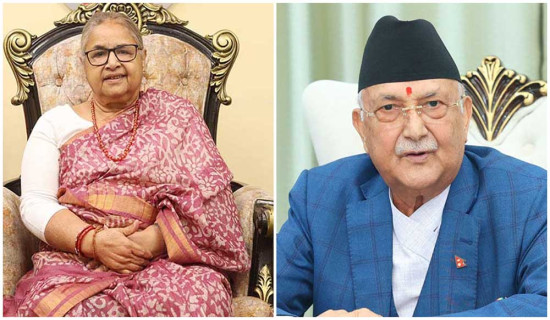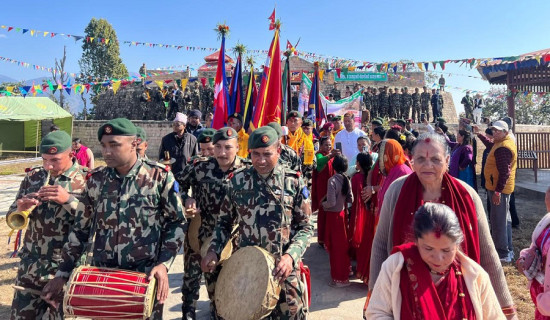- Friday, 9 January 2026
Extending Social Protection For All
Social protection is all about protecting the poor and vulnerable population of the country and sharing prosperity. It supports the economy and people’s livelihoods in the time of financial hardships and shocks. These shocks tend to produce and reproduce poverty and backwardness. Nepal has a long history of social protection although initial social protection was largely charity-based. As a matter of rich eastern cultural heritage, rich people and their households always donated cash or kind to the poor and unfortunate ones in Nepal. Our scriptures have urged to earn merit and goodness through charitable undertakings. This still motivates people to donate to the less fortunate. This works as a relief for coming out of various livelihood risks and vulnerabilities.
Consequently, people do not fall into poverty or come above the poverty line. Therefore, charity-based social protection interventions have the power to overcome some of the difficulties of the weaker section of the population. However, this type of charity-based social protection has its own limits in the face of increased population with increased exposure to various risks and vulnerabilities that demands for more and better social protection coverage.To address this demand, the government of Nepal has introduced few need-based social protection schemes in the past, such as the elderly cash allowances. Prime Minister Employment Programme is another need-based social protection intervention as it addresses some of the livelihood needs of the registered unemployed people through cash for work.
Better resilience
Other anti-poverty programmes are also need-based social protection interventions. They help people to meet their immediate needs such as cash, sanitation, health care or drinking water and access to roads and schools. Provision of these facilities ensures better resiliency for the households. With the introduction of rights-based development approach in the 1990s, Nepal has also introduced more and better social protection interventions to ensure the rights of different sections of the population. It has been widely accepted that without adequate social protection, various rights of the people cannot be realised in practice.
Social security for the labour, children and women are some to the examples of rights-based social protection interventions in Nepal. Nepal’s constitution has also acknowledged social protection as a right of every Nepali citizen. Along these three lines, social protection coverage has been expanding over the years. Currently about 87 social protection schemes are in operation by the government at the federal level alone. It costs about Rs. 20 million annually which is nearly five per cent of GDP and 14 per cent of the federal budget. Provincial and local governments also provide various social protection supports in their jurisdictions. Private sector and Non-Governmental Organisations and households also provide various meaningful social protection supports to the needy.
With this expansion in social protection, there is a need to review the existing social protection system. Such a review should help understand the gaps and challenges of social protection, and identify potential strategies for further extending the coverage. This will also help to further improve the adequacy of schemes and for the sustainable financing of the sector. The constitution has envisioned a welfare and socialism-oriented economy and society where there are no super-rich and super-poor. It demands for a system that leaves no one behind. In this light, extending social protection to all is a prerequisite for realising the spirit of the national charter.
The ongoing 15th plan also aims to increase social protection coverage from 17 per cent to 60 per cent. Increase in social protection coverage has also been identified as a prominent target for reducing all forms of poverty in the SDG framework. The importance of social protection for reducing poverty, inequality, risks and vulnerabilities have been widely documented. Rather than considered as an unproductive expenditure, social protection has proved to be a tool for increasing economic growth and inclusive development.
A recent study has estimated that the overall social protection coverage has increased to 32.9 per cent from the 17 per cent three years ago. Prime Minister Employment Programme and Social Security Fund are the main contributors here. Social health coverage has also increased to just 17.7 per cent due to the introduction of National Health Insurance Scheme. The overall increases in social protection to 32.9 per cent is nearly 100 per cent increase in coverage in the last three years, but only half way to the 15th plan’s target of extending it to 60 percent of the population.
Limited fiscal space
The government aims to further extend the social protection coverage and universalise socio-economic security. This will really translate the provisions of our constitution into action, thereby improving the conditions of people. But fiscal space is limited for this to happen. Taxing too much in order to finance universal social protection is not a good idea as higher taxes distorts the economy. It increases market price and reduces the economic pie. Therefore, it is necessary that the contributory social protection is increased so as to ensure the overall fiscal sustainability the schemes.
Let us hope that the new research findings will be very useful towards extending social protection in the country and realising the aspirations of our constitution, the ongoing periodic plan and the SDGs. Development is all about enlarging people’s choices. Such choices are enlarged only when social protection is universalised. Growing national and global level shocks also demand for more and better social protection coverage for all.
(Dr. Bhusal works at the National Planning Commission, Nepal)
















